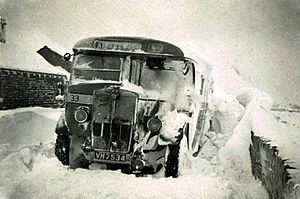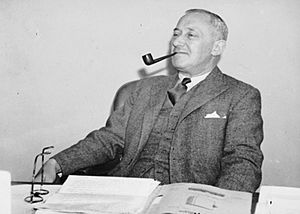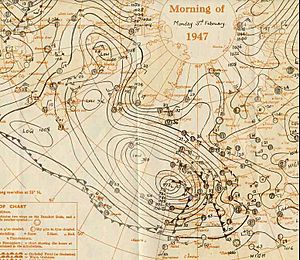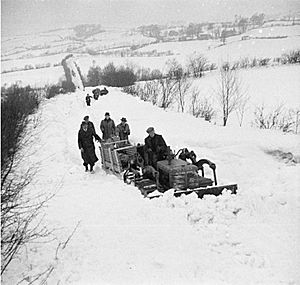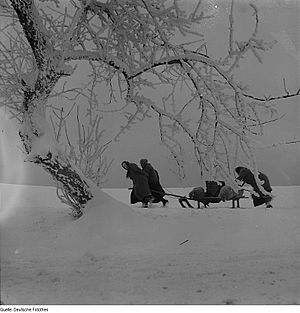Winter of 1946–47 in the United Kingdom facts for kids
The winter of 1946–1947 was a very tough time in the United Kingdom. It caused big problems for the country's economy and for people's daily lives. Britain was still recovering from World War II. There were huge issues with getting enough energy for homes, offices, and factories. Many farm animals died from the cold or from hunger. People suffered from the constant freezing temperatures. Lots of businesses had to close for a while. When warmer weather finally arrived, the ice and snow melted. This caused serious flooding in many low-lying areas.
Starting on January 23, 1947, the UK had several very cold periods. These brought huge snowdrifts that blocked roads and railways. This made it hard to move coal to the power stations. Many power stations had to shut down. This meant strict rules were put in place to save electricity. For example, homes could only have electricity for 19 hours a day. Some factories had their power cut completely. Also, radio shows were limited, TV services stopped, some magazines were told to stop printing, and newspapers became smaller.
These rules, along with the freezing temperatures, made people very unhappy. The Minister in charge of Fuel and Power, Manny Shinwell, became the target of public anger. People were so upset that he needed police protection. By the end of February, there were also worries about not having enough food. Supplies couldn't get through, and vegetables were frozen in the ground.
In mid-March, warmer air finally reached the country. This melted the snow on the ground quickly. But the ground was still frozen solid. So, the melting snow ran off fast into rivers. This caused widespread flooding. More than 100,000 homes were affected. The British Army and help from other countries were needed to assist people. After the cold weather ended and the ground thawed, there were no more weather problems.
This harsh winter had a big impact on British industries. About 10% of the year's factory production was lost. Farmers lost 10% to 20% of their grain and potato crops. A quarter of all sheep died. The government, led by the Labour Party, started to lose public support. This was one reason they lost many seats to the Conservative Party in the 1950 election. The winter is also thought to have played a part in the value of the British pound dropping. It also led to the Marshall Plan, which was a US plan to help rebuild Europe after the war. Other parts of Europe also suffered badly. For example, 150 people died from cold and hunger in Berlin. There were also problems in the Netherlands and businesses closed in Ireland.
Contents
Why was there a Fuel Shortage?
The problems of the cold winter were made worse by issues in the energy industry. This caused coal supplies to become very low. The coal and electricity industries had recently been taken over by the government. They were put under the control of Minister Manny Shinwell. Shinwell tried to increase coal production. But there were worries that there wasn't enough coal.
At the start of winter, coal storage piles only had enough coal for four weeks. Before the war, there was usually enough for ten to twelve weeks. However, Shinwell was given too hopeful reports about how much coal was being produced. These reports didn't match the real amount of coal being dug. The government was also careful not to upset the coal miners. Miners were taking more time off work than before the war.
The risk of a coal shortage made people buy electric heaters for their homes. This put even more pressure on the electricity supply. The extra demand from electric heaters in 1946 was about the same as the entire yearly increase in power production. Shinwell was warned in October that a coal shortage was possible. But he hoped for a mild winter to keep coal use low. He didn't want to risk a disagreement with the miners.
What Happened During the Winter?
January's Cold Start
The winter began with cold spells in December 1946 and January 1947. But the coldest part started on January 21, 1947. The main reason for the extreme cold was a high-pressure weather system. This system stayed over Scandinavia from January 20. This high-pressure area stopped storms from the Atlantic Ocean. It pushed them south of the United Kingdom. This caused strong winds from the east. These winds brought snow to eastern and south-eastern England. Then the snow spread across the whole country.
The cold weather continued. By January 30, the Isles of Scilly had 7 inches (18 cm) of snow. The temperature overnight at Writtle, Essex, was -20°C (-4°F). Throughout January, the highest temperature in England and Wales was 14°C (57°F). The lowest was -21°C (-6°F).
February's Deep Freeze
The easterly winds kept blowing into February. This made it one of the coldest months ever recorded. At Kew Observatory in London, the temperature never went above 5°C (41°F) all month. Only twice did the overnight temperature stay above 0°C (32°F). Kew had no sunshine for 20 days from February 2. Across England and Wales, February was the second-dullest February since records began in 1929. There were only 30.8 hours of sunshine, which is about 1.1 hours per day. In contrast, West Scotland was very dry and sunny, but still extremely cold.
On February 20, the ferry service between Dover and Ostend (Belgium) was stopped. This was because of thick ice off the Belgian coast. In some places, snow fell on 26 out of 28 days in February. A temperature of -21°C (-6°F) was recorded at Woburn, Bedfordshire, on February 25. Because of this, railways were badly affected by light, powdery snowdrifts. Three hundred main roads became unusable. Several hundred villages were cut off. Large pieces of ice were also seen off the coast of East Anglia. This made shipping dangerous.
This cold weather made the fuel problem even worse. Piles of coal at mines and storage places froze solid. They could not be moved. The snow also trapped 750,000 railway wagons full of coal. It made roads unusable, making transport even harder. A large group of 100,000 British and Polish soldiers, along with German prisoners of war, worked to clear snow from the railways by hand. People also tried hard to get fuel to power stations using coal-carrying ships. These ships risked storms, fog, and ice to reach their destinations.
Despite these efforts, a lack of fuel forced many power stations to shut down or produce less electricity. The Royal Navy started "Operation Blackcurrant." They used diesel generators on submarines to provide extra power to towns and dockyards near the coast.
Minister Shinwell tried to reduce coal use. He completely cut off electricity to factories. He also reduced the electricity supply for homes to 19 hours per day across the country. As a result, factories all over the country had to close. Up to four million people had to claim unemployment benefits. Even though so many people lost their jobs, there was not much public unrest. TV services were stopped completely. Radio broadcasts were reduced. Some magazines were told to stop publishing. Newspapers were cut in size to four pages. Food rations, which were still in place from World War II, were cut to levels even lower than during the war. These actions did not change how much coal was used, but they made people's spirits very low.
Even with Shinwell's actions, there wasn't enough fuel. Blackouts happened across large parts of the country. Even staff at Buckingham Palace, the Houses of Parliament, and London's Central Electricity Board had to work by candlelight. A trade meeting with people from Russia and Iceland was held without light or heating. One of the things discussed was buying coal from Britain. People had to queue at gasworks to collect coke to use as fuel. Supplies of aspirin also ran low because it was made from coal-tar back then. Thousands of chickens on farms died from the cold. Public transport services were cut to save fuel.
Shinwell became very unpopular with the public. He even received threats, and police had to guard his house. Despite this, he remained very popular with the miners. This made the government careful about firing him, in case it caused strikes. By February 27, sea conditions improved. More than 100 coal ships managed to unload their cargo at power stations. This helped to ease the fuel crisis.
During this time, there was a fear that food supplies could run out. This was due to the cold affecting vegetables, farm animals, and delivery trucks. In response, the government started a campaign to make "snoek" popular. This was a cheap fish from South Africa. But people found the fish tasted bad, and the fish stocks were eventually used as cat food. Many winter root vegetables could not be harvested because they were frozen into the ground. In some areas, special drills were used to dig them out. Frost destroyed 70,000 tons of potatoes. As a result, potatoes were rationed for the first time.
March's Thaw and Floods
On March 4–5, heavy snow fell. It left huge drifts across much of the country. Some were 7 meters (23 ft) deep in the Scottish Highlands. On March 5, one of the worst British blizzards of the 20th century happened. Food supplies were again affected by snow-blocked roads. In some places, the police asked for permission to break into delivery trucks stuck in the snow.
On March 10, milder air, around 7–10°C (45–50°F), began to move north from the south-west. This quickly melted the snow on low ground. However, after such a long freeze, the ground stayed frozen. The frozen ground caused a lot of water to run off the surface. This led to widespread flooding. More heavy snowfalls happened as the milder air pushed north. On March 14, the deepest snow ever recorded in a UK town was measured. It was at Forest-in-Teesdale in County Durham, at 83 inches (210 cm).
On March 15, a strong storm moved in from the Atlantic. It brought heavy rain and strong winds. This was the start of the wettest March in 300 years. By March 16, winds reached 50 knots (93 km/h) with gusts of 90 knots (170 km/h). This caused breaks in river banks in East Anglia. As a result, 100 square miles (260 km2) of land were flooded. Many trees were also blown down. The rivers Thames and Lea flooded in London. A local engineer said they would need "a spare Thames, or two" to cope.
On March 17–18, the River Trent overflowed its banks in Nottingham. Large parts of the city and nearby areas were flooded. 9,000 homes and almost 100 businesses were affected. Some homes were flooded up to the first floor. The suburbs of West Bridgford and Beeston suffered especially badly. So did nearby Long Eaton in Derbyshire, which had extensive flooding. Two days later, further down the river, the flood peak combined with a high spring tide. This flooded villages and 2,000 homes in Gainsborough. River levels dropped when a floodbank at Morton broke. This resulted in 77 square miles (200 km2) of farmland in the Trent valley being flooded.
The flooding in the west of the country went down by March 20. But rivers in the east were still rising. The Wharfe, Derwent, Aire, and Ouse all burst their banks in West Riding of Yorkshire. Selby was also badly affected, with 70% of houses flooded. More than 100,000 properties were affected by the flooding. The Army worked to stop the floodwater from spreading, especially at pumping stations and power stations. Soldiers helped deliver milk to families with babies. The Australian Red Cross also helped in Gloucester. People in Canada sent food parcels to villages in Suffolk. The leader of Ontario, Canada, even offered to help deliver them himself. The flooding lasted for about a week, with some waters taking another ten days to go down.
What were the Long-Term Effects?
The winter had a lasting impact on Britain's industries. By February 1947, it was thought that the year's industrial production would be down by 10%. The floods in March caused another £250–375 million in damage. This would be billions of pounds today. Farming was hit especially hard. Grain and potato harvests were 10% to 20% lower than in the previous two years. Sheep farmers lost a quarter of their flocks. It took six years for the number of sheep to recover.
In Wales, a special fund of £4,575,000 was set up. Part of this money helped farmers who lost about 4 million sheep.
The winter also had political effects. It made the public lose trust in the Labour government. People felt the government couldn't keep food and electricity supplies going. Minister Shinwell never publicly said the crisis was because of low coal supplies. Instead, he blamed the weather, the railway system, or capitalism. But the public blamed him. Shinwell was forced to resign in October. His resignation didn't fix the party's problems. The Labour Party lost many seats to the Conservative Party in the next election. Experts say that the fuel crisis of 1947 more than anything else made people lose faith in the Labour government.
The effects of the winter came at a time when the government was spending a lot of money. 15% of the country's income was spent on the armed forces. There was also a lot of spending on the new National Health Service and rebuilding after the war. This made the British currency less stable. Also, the US dollar became the main currency for international trade. This led the government to cut the official exchange rate of the pound from $4.03 to $2.80. This was a big moment in Britain's decline from being a global superpower.
With Britain struggling to feed its own people and those in war-torn Europe, the US became more interested in helping Europe. This led to the Marshall Plan, which provided aid to Britain and other European countries. The winter is also mentioned as a reason why thousands of British people moved away, especially to Australia. Overall, this winter was not as cold as the winter of 1963. But it had more snow.
How did the Winter Affect Other Countries?
The winter affected many other European countries. Similar cold periods and snowfalls were seen in much of Central Europe and the southern Baltic region. De Bilt, near Amsterdam in the Netherlands, had its worst winter since 1790. Because of the high-pressure system north of the UK, several storms from the Atlantic that would normally hit Britain went south instead. They tracked towards the Mediterranean region. This meant Portugal, Spain, and Southern France had more rain than usual, while staying relatively warm. For example, the rainfall in Gibraltar in February was 9.3 inches (240 mm), which was three times the average. As a result, France experienced both extreme cold in the north and a lot of rain in the south.
The winter caused 150 deaths from cold and lack of food in Berlin. The city was still recovering from the damage of World War II. It caused schools in the Netherlands to close. It led to a crowd attacking a train carrying coal in Copenhagen. It also caused businesses to close and gas supplies for homes to be limited in Ireland.
See also
- Weather of 1946
- 1947 in the United Kingdom
- 1947 Thames flood
- 1947 English cricket season
- Winter of 1962–1963 in the United Kingdom
- Winter of Discontent
- 1987 United Kingdom and Ireland cold wave
- Winter of 1990–1991 in Western Europe


